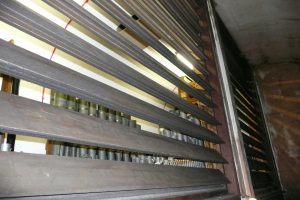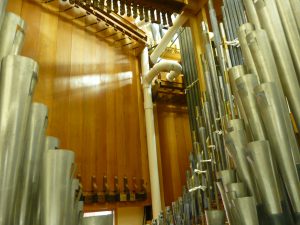Devices for varying the volume of sound reaching the auditorium. Constructed like giant venetian blinds, each slat (‘blade’) can swivel on its own axis under the control of the organist, by using the swell pedals.
A set of shutters usually comprises of between six and twelve blades; the size of the complete shutter assembly (“swell front”) normally varies between four feet to six feet high, and six feet to eight feet wide.

The axis of the blades may either be vertical (usual on Wurlitzers and Christies) or horizontal (usual on Comptons). Each blade may open and close independently, actuated by individual separate pneumatic motors, or the entire set of blades are linked together and open and close together in a gradual movement (under the control of a “whiffle-tree” machine).
Swell shutters are usually made of wood (up to two inches thick) but in some cases transparent materials have been used so that the pipework may be seen by the audience.
Most theatre organ shutters have grooves machined in the mating faces of the shutters. These were devised by Robert Hope-Jones and act as sound traps to prevent leakage of sound through the gaps between the blades. These grooves are visible in the top picture.

Whether with individual or whiffle-tree action, the swell shutters open or close progressively as the swell pedals on the console are moved by the organist.
The top picture shows a set of Compton shutters at the Apollo (former Gaumont) Hammersmith. The blade axis is horizontal and the shutters are opened together gradually, by a whiffle-tree machine.
The lower picture shows a set of Wurlitzer shutters with the blade axis vertical. Each shutter is opened by its own pneumatic motor; these are progressively actuated by the swell pedals to increase or decrease the volume of sound reaching the auditorium.
